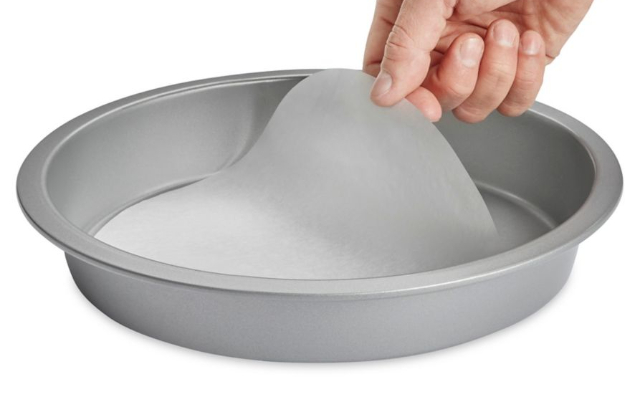It’s become something I find I have to review every year as the holiday season approaches. Folks who don’t cook intensively the rest of the year ramp up for a succession of holiday feasts. You may find it amusing or horrifying, depending on where you sit…
 Pre-cut round cake pan liner: Genuine parchment paper is the only
Pre-cut round cake pan liner: Genuine parchment paper is the only
product that does everything it does; accept no substitutes.
I always wonder what some folks are thinking when they out on their aprons and get o reading the recipes for their family’s holiday feast dishes. In recent years, I’ve come to realize it’s not really what they’re thinking, but whether they’re thinking at all.
We all made this mistake at some point
It’s a mistake we all made, or almost made, when we starting to learn to cook in earnest. Those of us who were under the wing of an experienced cook or a kitchen professional probably avoided the consequences of a bad choice. But those on their own, with only a cookbook to guide them, more than likely did pay a price in wasted food, and possibly even ruined cooking pans and utensils.
I refer to the abiding confusion surrounding parchment paper, what it actually is, and what it definitely is not.
What is parchment paper?
One of the most useful accessories in any pro kitchen is not a tool, a pan or a miracle appliance of some kind. It’s innocuous parchment paper, a substance that goes back as far as original parchment itself and owes its fame to unique properties that make it indispensable.
This pan-lining paper is not real parchment anymore – i.e.- as the Encyclopedia Britanica defines it: “the processed skins of certain animals — chiefly sheep, goats, and calves — that have been prepared for the purpose of writing on them.”
The namesake stuff we use today for cooking is not processed animal skins, of course. It’s generally described as stiff paper coated with food-safe materials that render it heat- and moisture-resistant.
In British cookbooks, they call it ‘greaseproof paper’.
Where and how is it used?
Thus we can use it to line cooking pans and storage containers to make them stick-proof. Those little accordion-folded cupcake pan liners are parchment paper. Cake fans often use flat sheets of parchment paper to line their baking tins. Cookie pros always use parchment paper to line their baking sheets.
Though primarily used in the bakery, the pros also use it extensively to line oven-destined cooking vessels such as roasting pans and sheet pans to prevent sticking, and facilitate post-cooking cleanup.
Parchment paper is indispensable when cooking chicken or fish or veggies en papillote, French for ‘wrapped in paper’. Because it’s moisture- and heat-resistant, you’re actually steaming the food, which cooks it faster and helps retain the food’s natural colour, flavour, aroma and nutrients. Delicate foods won’t burn or dry out during cooking. Bonus: your guests receive individual paper packets of properly proportioned foods, which they get to unwrap themselves at the table!
In short, you can use parchment paper to streamline cooking and clean-up processes anywhere you want to – provided you keep cooking and baking temperatures below 425-450 F. As I said, somewhere way back at he beginning of this post, the stuff may be a miracle material but it’s not scorch- or flame-proof, just ‘resistant’…
Accept no substitutes!
And here’s where novice and casual cooks get into sometimes comic, sometimes tragic situations.
The most common mistake they make is mistaking parchment paper and wax paper. Like parchment paper, wax paper is also moisture- and grease-resistant. But it’s coated with real wax, which will melt or even burn at temperatures well below 450 F. Even if there’s no smoke or flames, your food and cooking vessels may both be ruined.
You can’t replace parchment paper with plain paper, newsprint or butcher paper, either. All have their drawbacks. But the worst choice as a ‘substitute’ for parchment may be butcher paper.
According to masterclass.com, it is, “made out of kraft pulp treated with caustic soda and sulfide as well as sizing agents to help prevent leaking. […] White butcher paper is often used for crafts and [for] table covering. [It’s] uncoated, and perfect for wrapping sandwiches and subs.”
Pink butcher paper is opaque and very moisture-resistant; great for wrapping raw meats. It’s ‘varnished’ on one side with a silcone-based coating that resists soak-through by a wide range of liquids. The most dangerous thing is, it’s not temperature-resistant. Never use it in the oven!
So…
If you don’t have parchment paper in your pantry already, get a roll next time you’re at the supermarket. Or make a side trip to a local restaurant supply outlet and get a box of flat, precut sheets – the format the pros rely on.
Just be sure to use it as it is intended to be used. And don’t even think about substituting anything else that may look alike and promise to save you some money. Genuine parchment paper will save you money in the long run and make your kitchen life a lot more livable. Especially when those annual family feast days come ’round!
~ Maggie J.

